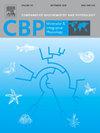Hypoxia impairs survival and alters immune and iron metabolism gene expression during shark early ontogeny
IF 2.2
3区 生物学
Q4 BIOCHEMISTRY & MOLECULAR BIOLOGY
Comparative Biochemistry and Physiology A-Molecular & Integrative Physiology
Pub Date : 2025-07-10
DOI:10.1016/j.cbpa.2025.111904
引用次数: 0
Abstract
The global oxygen inventory has been declining worldwide, primarily due to climate change. The importance of oxygen for aerobic respiration and its homeostasis makes declining oxygen levels a concern, particularly during energy demanding lifecycle stages. The effects of low oxygen levels on neuroendocrine responses and immune competence of developing sharks were studied in the head and trunk tissues of early (EE; before pre-hatching) and late embryos (LE) of small-spotted catshark (Scyliorhinus canicula) under six days of deoxygenation (93 % O2 of air saturation) and hypoxic conditions (26 % O2). Catshark embryos were resilient to deoxygenation, with only a 10 % decline in survival compared to the control, and only the gene expression of melanotransferrin changed. Under hypoxia, growth was unaffected, but survival decreased by 31 % compared to the control in LE, highlighting an inadequate physiological response. Developmental stage affected the expression of hypoxia-inducible factor 1 alpha (hif1a), iron metabolism and immune-related genes, pointing to critical response mechanisms. The EE stage had an optimised stress response under hypoxia compared to LE, with the upregulation of the hif1a gene. The lack of a protective response and compromised immune-related functions under hypoxia in LE raise concerns about species survival under climate change. These findings highlight the need for further research on the likely resilience of sharks to environmental challenges.

缺氧损害生存和改变免疫和铁代谢基因表达在鲨鱼早期个体发育。
全球氧气储量在全球范围内一直在下降,这主要是由于气候变化。氧气对有氧呼吸及其体内平衡的重要性使氧气水平下降成为一个问题,特别是在能量需求旺盛的生命周期阶段。研究了低氧水平对早期鲨鱼头部和躯干组织神经内分泌反应和免疫能力的影响;小斑点猫鲨(Scyliorhinus canicula)在6天的缺氧(空气饱和度为93 % O2)和缺氧(26 % O2)条件下的早期胚胎(LE)。猫鲨胚胎对缺氧有弹性,与对照组相比,存活率仅下降了10% %,只有黑素转铁蛋白的基因表达发生了变化。在低氧条件下,生长不受影响,但与对照组相比,存活率下降了31% %,突出了生理反应不足。发育阶段影响了缺氧诱导因子1 α (hif1a)、铁代谢和免疫相关基因的表达,提示了关键的应答机制。与LE相比,EE阶段在缺氧条件下具有优化的应激反应,hif1a基因上调。缺氧条件下LE缺乏保护性反应和免疫相关功能受损引起了对气候变化下物种生存的关注。这些发现强调了进一步研究鲨鱼对环境挑战的可能恢复力的必要性。
本文章由计算机程序翻译,如有差异,请以英文原文为准。
求助全文
约1分钟内获得全文
求助全文
来源期刊
CiteScore
5.00
自引率
4.30%
发文量
155
审稿时长
3 months
期刊介绍:
Part A: Molecular & Integrative Physiology of Comparative Biochemistry and Physiology. This journal covers molecular, cellular, integrative, and ecological physiology. Topics include bioenergetics, circulation, development, excretion, ion regulation, endocrinology, neurobiology, nutrition, respiration, and thermal biology. Study on regulatory mechanisms at any level of organization such as signal transduction and cellular interaction and control of behavior are also published.

 求助内容:
求助内容: 应助结果提醒方式:
应助结果提醒方式:


